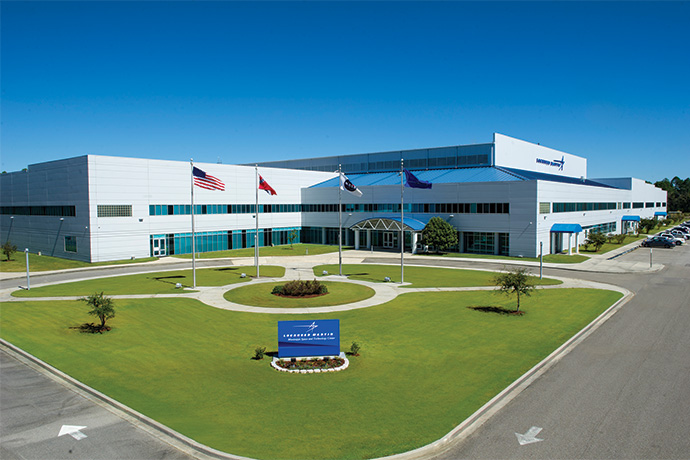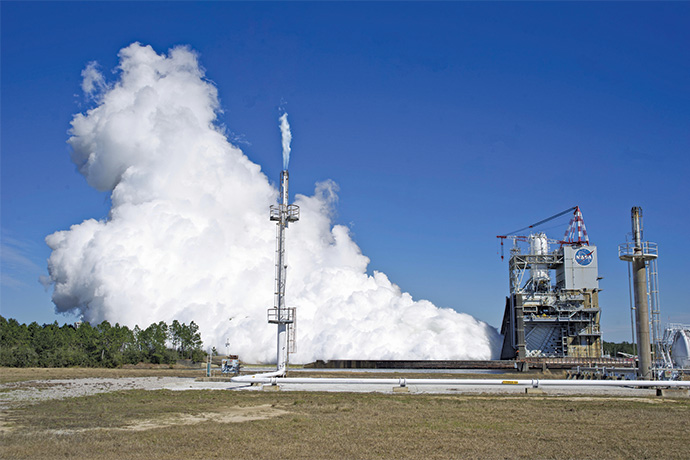Stennis Space Center in Mississippi does not get the same attention shown to the Kennedy Space Center or Cape Canaveral, but it should. Every rocket engine carrying American astronauts into space first passes muster at Stennis Space Center.
Located near the Pearl River, Stennis Space Center is a confluence of government agencies, businesses, and 5,000 people in what Paul Foerman, NASA Office of Communications at Stennis Space Center, calls a federal city with all the amenities of a small town. For security and safety, the space-center grounds comprise 13,800 acres in southern Mississippi surrounded by another 125,000 acres of acoustical buffer zone.
Stennis Space Center is not the only rocket-engine evaluation facility in the US, but it is the largest, meaning the most powerful rocket engines are tested at Stennis. Not a simple task, when rockets engines by design move things. “Kennedy Space Center has it easier, they light the engines and let ‘em’ go,” jokes Foerman. “We have to hold the engines down.”
Private Companies Test at Stennis
The capabilities at Stennis are not lost on private-sector companies. For example SpaceX, a rocket and spacecraft manufacturer founded in 2002, along with NASA, recenlty held a ribbon-cutting ceremony at the retrofitted Stennis E-2 test stand, where SpaceX now tests components of its methane-fueled Raptor rocket engine.
“SpaceX is proud to bring the Raptor testing program to NASA’s Stennis Space Center and the great state of Mississippi,” said Gwynne Shotwell, president and COO of SpaceX. “In partnership with NASA, SpaceX has helped create one of the most advanced engine-testing facilities in the world, and we look forward to putting the stand to good use.”
Stennis is home to several other civilian companies, including Lockheed Martin and Rolls-Royce. Lockheed Martin along with NASA, Hancock County, and the state of Mississippi, formed the Mississippi Space & Technology Center (MS&TC). The group’s building encompasses 220,000 square feet with 50,000 square feet of clean-room space for building satellite spacecraft and their maneuvering propulsion systems.
“Incentives from Mississippi and the state’s competitive labor rates enabled the partnership,” says David Hartley, director, Propulsion Manufacturing Center at Lockheed Martin Space Systems. “The MS&TC created many high-tech jobs, and produced over 53 propulsion subsystems for Lockheed Martin satellites.”
In 2007, Rolls-Royce North America was looking for a site to build a new test facility. The jet-engine manufacturer needed outdoor test stands to qualify their jet engines for noise-limit and crosswind capability certifications.
Stennis Space Center, with its acoustical buffer zone, turned out to be ideal for Rolls-Royce. So much so, the company added another test stand in 2013.
“Mississippi created a positive partnership with Rolls-Royce,” says Anthony Woodard, general manager for Rolls-Royce Stennis Test Facility. “Add to that the perfect location for testing jet engines and access to a skilled aerospace workforce, made expanding our facility at Stennis the right choice.”

MS&TC entrance at Stennis Space Center
Image courtesy Lockheed Martin
Trained Workforce
For companies looking for trained aerospace workers, Mississippi is the place to go. The state’s university system is geared towards aerospace. “Mississippi has the fastest growing aerospace industry in the country,” says Brent Christensen, executive director of the Mississippi Development Authority. “Colleges work with tech companies to design and implement the specialized training programs aerospace employers need to be productive.”
“SpaceX is proud to bring the Raptor testing program to NASA’s Stennis Space Center and the great state of Mississippi.“
— Gwynne Shotwell, president and COO, SpaceX
One example would be Mississippi State University’s (MSU) Raspet Flight Research Laboratory. The world-class flight-research facility focuses on meeting the needs of students, government agencies and commercial customers. Raspet also acts as an incubator for various aerospace start-ups in Mississippi by providing work areas, technical training and access to other MSU assets such as the Center for Advanced Vehicular Systems.
State and Local Incentives
Both Rolls-Royce and Lockheed Martin have used of the valuable incentives Mississippi offers. Those incentives include:
- Sales and Use Tax Exemption for Construction or Expansion
- Skills Training Income Tax Credit Research and Development Skills Tax Credits
One incentive program that directly applies to companies like SpaceX, Rolls-Royce and Lockheed Martin is the Mississippi Aerospace Initiative Incentives Program, which provides corporate tax incentives to companies that make or assemble components for the aerospace industry; provide research, development or training services for the sector; and are looking to locate or expand in the state.
The Stennis Space Center is located in Hancock County, along with a helpful group of people comprising the Hancock County Port and Harbor Commission. As the Economic Development Authority for Hancock County, the commission works with companies to find applicable state and local incentives.
